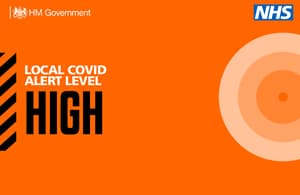- The Midlands, North East, parts of the North West and parts of the South West among those escalated to Tier 4, with almost all remaining areas escalated to Tier 3
- Spread of the new strain of COVID-19 is increasing in the South West, Midlands and parts of the North West
After careful consideration of the latest data, the following local authority areas will move to Tier 4: Stay at Home from the beginning of Thursday 31 December 2020:
- Leicester City
- Leicestershire (Oadby and Wigston, Harborough, Hinckley and Bosworth, Blaby, Charnwood, North West Leicestershire, Melton)
- Lincolnshire (City of Lincoln, Boston, South Kesteven, West Lindsey, North Kesteven, South Holland, East Lindsey)
- Northamptonshire (Corby, Daventry, East Northamptonshire, Kettering, Northampton, South Northamptonshire, Wellingborough)
- Derby and Derbyshire (Derby, Amber Valley, South Derbyshire, Bolsover, North East Derbyshire, Chesterfield, Erewash, Derbyshire Dales, High Peak)
- Nottingham and Nottinghamshire (Gedling, Ashfield, Mansfield, Rushcliffe, Bassetlaw, Newark and Sherwood, Nottinghamshire, Broxtowe)
- Birmingham and Black Country (Dudley, Birmingham, Sandwell, Walsall, Wolverhampton)
- Coventry
- Solihull
- Warwickshire (Rugby, Nuneaton and Bedworth, Warwick, North Warwickshire, Stratford-upon-Avon)
- Staffordshire and Stoke-on-Trent (East Staffordshire, Stafford, South Staffordshire, Cannock Chase, Lichfield, Staffordshire Moorlands, Newcastle under Lyme, Tamworth, Stoke-on-Trent)
- Lancashire (Burnley, Pendle, Blackburn with Darwen, Ribble Valley, Blackpool, Preston, Hyndburn, Chorley, Fylde, Lancaster, Rossendale, South Ribble, West Lancashire, Wyre)
- Cheshire and Warrington (Cheshire East, Cheshire West and Chester, Warrington)
- Cumbria (Eden, Carlisle, South Lakeland, Barrow-in-Furness, Copeland, Allerdale)
- Greater Manchester (Bolton, Bury, Manchester, Oldham, Rochdale, Salford, Stockport, Tameside, Trafford, Wigan)
- Tees Valley (Darlington, Hartlepool, Middlesbrough, Redcar and Cleveland, Stockton-on-Tees )
- North East (County Durham, Gateshead, Newcastle-upon-Tyne, North Tyneside, Northumberland, South Tyneside, Sunderland)
- Gloucestershire (Gloucester, Forest of Dean, Cotswolds, Tewkesbury, Stroud, Cheltenham)
- Somerset Council (Mendip, Sedgemoor, Somerset West and Taunton, South Somerset)
- Swindon
- Bournemouth, Christchurch and Poole
- Isle of Wight
- New Forest
The following local authority areas will move to Tier 3: Very High from the beginning of Thursday 31 December 2020:
- Rutland
- Shropshire, and Telford and Wrekin
- Worcestershire (Bromsgrove, Malvern Hills, Redditch, Worcester, Wychavon, Wyre Forest)
- Herefordshire
- Liverpool City Region (Halton, Knowsley, Liverpool, Sefton, Wirral, St Helens)
- York and North Yorkshire (Scarborough, Hambleton, Richmondshire, Selby, Craven, Ryedale, Harrogate, City of York)
- Bath and North East Somerset
- Devon, Plymouth, Torbay (East Devon, Exeter, Mid Devon, North Devon, South Hams, Teignbridge, Torridge, West Devon, Plymouth, Torbay)
- Cornwall
- Dorset
- Wiltshire
Between 18 and 24 December the weekly case rate in England rose to 402.6 per 100,000, a 32% increase on the previous week. The NHS reports 14,915 patients have been admitted to hospital with COVID-19 in the past week, a 18% increase on the week before.
Evidence shows the new strain of COVID-19 is increasing in the South West, Midlands and parts of the North West. The majority of the cases identified in London, the South East and the East of England are of the new variant. Infection rates have increased faster than expected in these areas where the new strain has been circulating and stronger measures are required to get the virus under control.
Rates in the East Midlands have increased to 256.1 per 100,000, a 17% increase on the previous week. Rates in the West Midlands have increased to 273.5 per 100,000, a 23% increase on the previous week. In the North West, rates have increased by 31% to 223.9 per 100,000. In the South West, there has been a 37% increase in cases to 175.1 cases per 100,000. While rates in the South West may be lower than other areas, the data shows a sharp upwards trajectory.
Winter is always the most difficult time of year for the NHS and an increase in COVID-19 infections is followed closely by a rise in hospitalisations and, after a lag, an increase in deaths. It is vital everyone plays their part by following the regional tiered restrictions in their area to bring down infections, save lives and reduce pressures on the NHS this winter.
All clinically extremely vulnerable individuals will be asked to shield if they live in Tier 4 areas. People will be sent a letter or email with advice and details of support. In the meantime they should follow the shielding advice set out on GOV.UK.
Tier 3 and 4 areas will continue to be prioritised for community testing, with more than 100 local authorities now having signed up to the enhanced testing support programme.
All available data has been assessed by the government, including the Health and Social Care Secretary, NHS Test and Trace including the Joint Biosecurity Centre (JBC), Public Health England (PHE), the Chief Medical Officer and the Cabinet Office. Data assessed includes how quickly case rates are going up or down, cases in the over-60s, pressure on the NHS and local circumstances.





